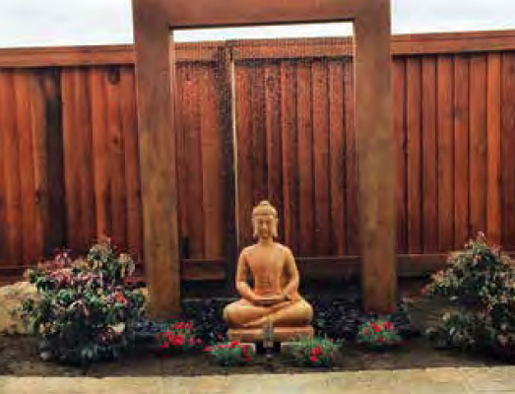
Over the last decade, the pond industry has seen many changes in direction. Fewer ponds are being put in the ground, with many homeowners opting instead for pond-free waterfalls or fountains. In more recent years, there has been a growing trend toward formal wall fountains, or water walls. Pond supply manufacturers have had to race to expand their offerings to keep up with the exponentially growing demand.
It is my belief that formal wall fountains have never been far from consumers’ minds. The main issue in the past has been the lack of available equipment, with most professional installations utilizing custom-made spillways or expensive spouts designed for the pool industry. Now that product lines have expanded to include stainless steel, acrylic and brass options for spillways (and not to mention wall spouts of every size and shape), the design possibilities are endless. Homeowners and water feature installers alike are now able to design and build professional grade wall fountains in a variety of styles and shapes.It is important to note that water walls and wall fountains can be installed in a space a fraction of the size required for ponds, making them perfect for customers with small backyards, condo owners and those who just wish to hear the sound of water without the presence of or maintenance associated with a full-sized pond.
Equipment Options

Some water feature builders create wonderful, custom wall fountains using large sheets of glass or metal in limitless combinations. These artistic designs are built with locally sourced raw materials and powered by an appropriately sized submersible pump. However, there is a growing number of products in the water feature industry specifically made to make building water walls easier for consumers and installers alike. Acrylic spillways are offered by nearly every pond supply manufacturer.
These can come with and without solid-color and color-changing light strips. These spillways allow for the creation of water walls and custom wall fountains with a solid sheet of water falling down. They range from only 6 inches wide to more than 4 foot in length, with a typical waterfall lip of 2 inches. Acrylic spillways are made to a height that easily allows for installation in block walls. Advantages of acrylic spillways include lower price, ease of installation, less water flow required and resistance to discoloration. However, they can easily be damaged during ship-ping and installation, and the narrow gap that allows the fine sheet of water can get clogged with debris. A filter is required on the pump feeding the spillway.

Another option is metal spillways, or scuppers — two words often used interchangeably. The products themselves may be found in 304 stainless steel (for non-chlorinated use), 316 stainless steel (for pools and chlorine-treated fountains) and copper or copper finish. Sizes range from 12 inches to more than 6 feet wide, with various forms of strip lighting available to illuminate them. The water spillway lips range from 2 to 15 inches, which allows considerable freedom in the placement of the catch basin. Some metal scuppers are made to thrust the water back against the wall itself rather than spill down in a sheet of water.
These types of water walls allow for a higher volume of water flow, with internal baffles spreading the water easily across the face. Their appearance is often considered more stately than the less expensive acrylic spillways, and the variety of styles and finishes provides more options for appearance and installation. Things to look out for include frequent discoloration, or patina (which some customers love), corrosion when using non-316 stainless steel in chlorinated situations, and the tendency for longer spillways to bend during shipping or installation.

If you’re looking for yet another option, there has been an explosion of new metal wall spouts from a variety of manufacturers over the past two to three years. These spouts have long been used in the pool industry, but lately we are seeing more and more pond projects utilizing these stately and versatile spouts. They are offered in 304 stainless steel, electropolished stainless steel (for extra chlorine resistance), solid brass, bronze finish and copper finish. Styles include square, round and oval, each with a multitude of mounting plates to add additional style when installed. Flows range from 5 to 20 gallons per minute, per spout. The expansive variety of metal spouts available on the market ensures a style for every taste.

They are also sturdy, easy to install and scalable, allowing you to use as few or as many as needed for the project. Still, keep an eye out for possible long-term discoloration or corrosion when using certain finishes in chlorinated situations.
Illuminate a water wall using any of the endlessly versatile LED lighting products that lend them-selves to many different water feature applications. Lighting strips can be found in many sizes, ranging from only 6 inches to well over 5 feet. These strips can be a solid color, such as white, or blue or red, or offer programmable options for color-changing lights. Recent advances have added both WiFi and app control at your fingertips. You can utilize lighting in many ways, including spout lights, corrosion-resistant lighting for chlorinated use and accent lighting for in and around the water feature.
Using the different types of products discussed in this article allows for countless styles of water wall features. While it is hard to replace the amazing creations that artists may custom build, water walls bring afford-ability, versatility and beauty to the many homeowners and businesses who install them.

As the wants and needs of consumers continue to change, the water feature industry must work to keep up. Smaller, more formal and creative features are taking their place alongside larger, natural-looking ponds and water gardens. While having fewer ponds going in the ground is a cause of concern for many pond builders, their fears can be cast aside by embracing this trend toward formal wall fountains and water walls.


